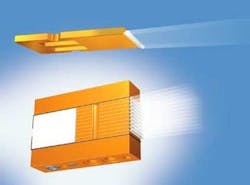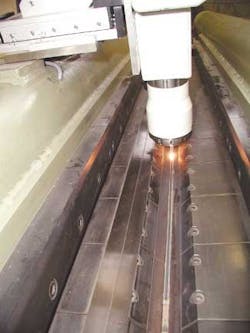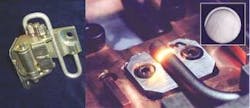Today, semiconductor lasers can be found almost everywhere—in the supermarket barcode scanner, in every CD player and in every computer equipped with a CD-ROM drive. They are also used to surf the Internet, send e-mail and make long-distance phone calls. Over the past few years, high-power lasers, with a power range up to several kilowatts, became available for industrial materials processing where their specific features opened up new applications, which might not have been attractive, or even possible, with conventional laser techniques.
Figure 1. Stacking diode laser bars mounted on microchannel heat sinks allow power increase up to 1 kW from one stack—at the expense of beam quality.
CO2 and solid-state lasers generate a single high-power laser beam in their respective active medium, which is gas or a specifically doped crystal. Typically only a few milliwatts can be extracted from a diode laser element. To increase power, many such elements can be combined into a diode bar, which has a size of about 10 mm × 0.6 mm × 0.06 mm. In a typical configuration the emitting surface is a narrow line, consisting of about 20 to 25 single lasers, which are located next to each other with a small gap. To reach high power without thermal damage, the laser bars must be efficiently cooled. This is performed by the use of micro-channel coolers, which allow for output powers exceeding 40 W. Further increases in power can be reached by mounting many of these laser bars on top of each other, called a stack (see Fig. 1). For even higher powers, several of these stacks can be combined into a unit by polarization and wavelength coupling. Today such a unit delivers a maximum of 6 kW with wavelengths ranging from 790 to 980 nm. The stacking of bars and the combination of stacks is all incoherent coupling, however, which affects the beam quality and therefore the focusability, resulting in a lower power density on the workpiece compared to conventional lasers. For this reason, the applications for high-power diode lasers are limited; in fact, they complement conventional lasers rather than compete with them.
Figure 2. Welding of sinter sieve drums for the pharmaceutical industry using a Rofin DL 025 S, 2mm stainless steel.
Nevertheless, diode lasers show a number of decisive advantages. They are compact, which makes them ideally suited for integration into existing machining systems (see Fig. 2). Due to their long lifetimes, diode lasers show a high reliability, are virtually maintenance free and feature wall-plug-efficiencies exceeding 25 percent. These advantages make diode lasers an attractive alternative for some industrial applications, especially where focusability is of minor importance.
As a consequence of the lower beam quality, diode lasers are rarely used for classical applications for high-power lasers, such as cutting and deep penetration welding. The latter has been proven in university labs, but there is still some way to go before commercialization, and there is no industrial installation reported so far.
But there are applications where the beam characteristics of the diode lasers can be favorably used. Today, diode lasers are predominantly used in industrial production for heat conduction welding, brazing, hardening, soldering and plastics applications.
Heat conduction welding: Esthetics count—The possibility of producing high-quality overlap welds in thin metal sheets drove one of the very early industrial installations: welding of kitchen sinks, where stainless steel sheets with thicknesses of 1 mm are welded. The use of the diode lasers produced an almost invisible weld seam, which eliminated the need for a post-weld grinding process. Thus, the higher investment costs for the laser system compared to the conventionally used roll-welding process was offset. With a Rofin 2.5-kW diode laser, welding speeds exceeding 1 m/min were achieved, using the diode laser in combination with a robot.
Brazing: An alternative to welding or gluing—Increasingly, brazing has become an established technology for joining parts in automotive production, particularly for seams that must have the best possible visual appearance and those that have a high geometrical tolerance in the parts to be joined. Today, most of the industrial installations are still done with defocused solid-state lasers, but there is a good chance for diode lasers to gain market share, as they are perfectly suited for this application due to their beam characteristics. Initial tests show promising results that lead to significant cost reduction.
Hardening: The "killer" application—Due to their rectangular beam shape and shorter wavelength of 808 and/or 940 nm, diode lasers are the ideal tools for hardening applications. Annoying pre-painting of the workpiece, which is needed to increase the absorption when CO2 lasers are used, is eliminated.
A typical example is hardening of car door S-shaped springs used in door hinges (see Fig. 3). As they are subject to massive friction when the doors are opened and closed, the surface in the respective area has to be hardened, covering an angle of more than 170° and a length of roughly 12 mm with a hardening depth of 0.2 to 0.4 mm. High-power diode lasers not only have the ideal beam profile, but they have proven to be the most inexpensive and most reliable manufacturing solution for this application. For more than two years, two machines with two Rofin DL 015 lasers each are producing the springs, three shifts per day, six days per week.
Figure 3. Car door hinge: the s-shaped torsion springs are hardened with a diode laser to reduce the friction in the area of the clamping rolls.
Soldering: Excellent results at minimal power—Laser soldering of electronic components has been used for some time, in particular with Nd:YAG lasers at powers up to 150 W. Laser soldering offers advantages compared to conventional techniques. Because it is non-contact machining, even parts with a difficult accessibility can be processed and the position can be easily controlled minimizing the thermal input on the workpiece. This is especially important for small electronic parts that are sensitive to heat and/or pressure. With smaller diode lasers, integration into existing soldering machines is markedly easier.
Plastics: The invisible weld—Joining of plastics has been demonstrated with CO2 and Nd:YAG lasers, however, no major application breakthrough has occurred. In the preceding applications, the absorption, which is necessary to couple energy into the material, is automatic. In polymer welding a special configuration must be chosen. The ideal configuration is achieved if an overlap welding process can be used in which the top material is transparent to the laser radiation, while the bottom one is absorbing. Here, the maximum absorption takes place at the interface and a good joint can be accomplished. Industrial installations are still limited. However, numerous research projects, first steps into industrial production, and a couple of new start-up companies are focusing on this application to prove the efficacy of this method.
Outlook: A shining future
Although the market for diode lasers in industrial materials processing is still very small, market experts believe in higher proportional growth for the future. Diode lasers will gain market share and attain a position in the industrial laser market. The discovery of new applications and markets is the driving force today, because the traditional laser processes—deep welding and cutting—cannot be done satisfactorily with today's available high-power diode lasers. However, the ongoing development to improve output power and beam quality seem to open up the possibility of entering traditional markets on the condition that the attractive advantages of the high-power diode lasers (such as reasonable investment costs, high wall plug efficiency and long diode life) can be maintained or even improved. Then, high-power diode lasers in industrial materials processing will not be a niche player anymore.
Thorsten Frauenpreiss ([email protected]) is PR and marketing manager of Rofin-Sinar Laser GmbH. Dr. Friedrich Bachmann ([email protected]) is product manager diode lasers of Rofin-Sinar Laser GmbH.


